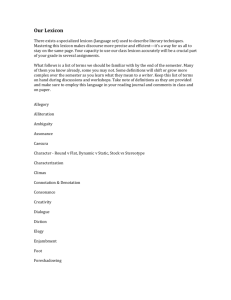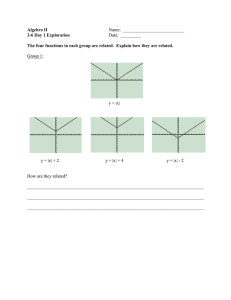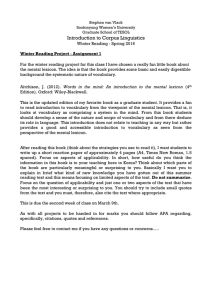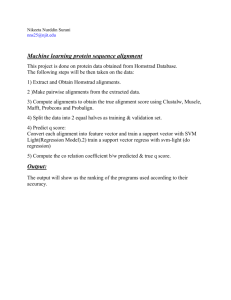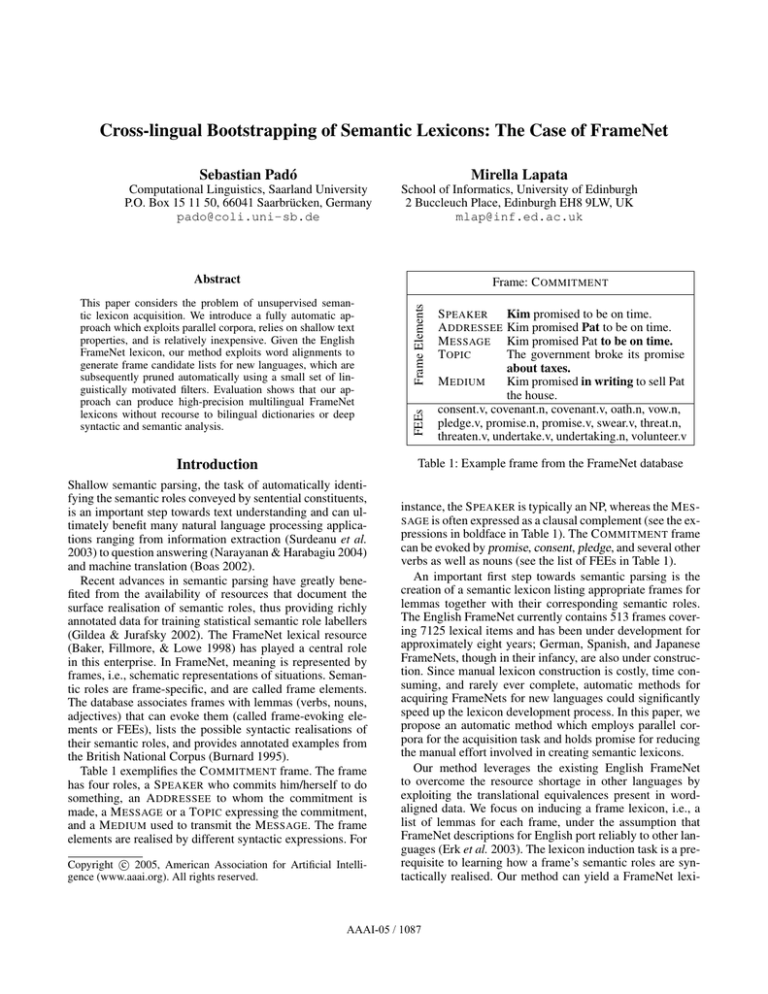
Cross-lingual Bootstrapping of Semantic Lexicons: The Case of FrameNet
Sebastian Padó
Mirella Lapata
Computational Linguistics, Saarland University
P.O. Box 15 11 50, 66041 Saarbrücken, Germany
pado@coli.uni-sb.de
School of Informatics, University of Edinburgh
2 Buccleuch Place, Edinburgh EH8 9LW, UK
mlap@inf.ed.ac.uk
Abstract
Introduction
FEEs
This paper considers the problem of unsupervised semantic lexicon acquisition. We introduce a fully automatic approach which exploits parallel corpora, relies on shallow text
properties, and is relatively inexpensive. Given the English
FrameNet lexicon, our method exploits word alignments to
generate frame candidate lists for new languages, which are
subsequently pruned automatically using a small set of linguistically motivated filters. Evaluation shows that our approach can produce high-precision multilingual FrameNet
lexicons without recourse to bilingual dictionaries or deep
syntactic and semantic analysis.
Frame Elements
Frame: C OMMITMENT
Kim promised to be on time.
Kim promised Pat to be on time.
Kim promised Pat to be on time.
The government broke its promise
about taxes.
M EDIUM
Kim promised in writing to sell Pat
the house.
consent.v, covenant.n, covenant.v, oath.n, vow.n,
pledge.v, promise.n, promise.v, swear.v, threat.n,
threaten.v, undertake.v, undertaking.n, volunteer.v
S PEAKER
A DDRESSEE
M ESSAGE
T OPIC
Table 1: Example frame from the FrameNet database
Shallow semantic parsing, the task of automatically identifying the semantic roles conveyed by sentential constituents,
is an important step towards text understanding and can ultimately benefit many natural language processing applications ranging from information extraction (Surdeanu et al.
2003) to question answering (Narayanan & Harabagiu 2004)
and machine translation (Boas 2002).
Recent advances in semantic parsing have greatly benefited from the availability of resources that document the
surface realisation of semantic roles, thus providing richly
annotated data for training statistical semantic role labellers
(Gildea & Jurafsky 2002). The FrameNet lexical resource
(Baker, Fillmore, & Lowe 1998) has played a central role
in this enterprise. In FrameNet, meaning is represented by
frames, i.e., schematic representations of situations. Semantic roles are frame-specific, and are called frame elements.
The database associates frames with lemmas (verbs, nouns,
adjectives) that can evoke them (called frame-evoking elements or FEEs), lists the possible syntactic realisations of
their semantic roles, and provides annotated examples from
the British National Corpus (Burnard 1995).
Table 1 exemplifies the C OMMITMENT frame. The frame
has four roles, a S PEAKER who commits him/herself to do
something, an A DDRESSEE to whom the commitment is
made, a M ESSAGE or a T OPIC expressing the commitment,
and a M EDIUM used to transmit the M ESSAGE. The frame
elements are realised by different syntactic expressions. For
c 2005, American Association for Artificial IntelliCopyright gence (www.aaai.org). All rights reserved.
instance, the S PEAKER is typically an NP, whereas the M ES SAGE is often expressed as a clausal complement (see the expressions in boldface in Table 1). The C OMMITMENT frame
can be evoked by promise, consent, pledge, and several other
verbs as well as nouns (see the list of FEEs in Table 1).
An important first step towards semantic parsing is the
creation of a semantic lexicon listing appropriate frames for
lemmas together with their corresponding semantic roles.
The English FrameNet currently contains 513 frames covering 7125 lexical items and has been under development for
approximately eight years; German, Spanish, and Japanese
FrameNets, though in their infancy, are also under construction. Since manual lexicon construction is costly, time consuming, and rarely ever complete, automatic methods for
acquiring FrameNets for new languages could significantly
speed up the lexicon development process. In this paper, we
propose an automatic method which employs parallel corpora for the acquisition task and holds promise for reducing
the manual effort involved in creating semantic lexicons.
Our method leverages the existing English FrameNet
to overcome the resource shortage in other languages by
exploiting the translational equivalences present in wordaligned data. We focus on inducing a frame lexicon, i.e., a
list of lemmas for each frame, under the assumption that
FrameNet descriptions for English port reliably to other languages (Erk et al. 2003). The lexicon induction task is a prerequisite to learning how a frame’s semantic roles are syntactically realised. Our method can yield a FrameNet lexi-
AAAI-05 / 1087
con for any language for which English parallel corpora are
available. To show its potential, we investigate the induction
of FrameNet lexicons for German and French.
In the following section, we provide an overview of related work on automatic construction of multilingual resources. Then, we introduce our FrameNet-based lexicon
induction algorithms. Next, we present our experimental
framework and data. Evaluation results and their discussion
conclude the paper.
s, t
si , tj
f
pc (f |t)
si 1 tj
tp(si , tj , f )
f ee(f, s)
wsd(f, si )
cont(si )
cand(t, f )
Related Work
The automatic construction of bilingual lexicons has a long
history in machine translation (see Melamed (1996) and the
references therein). Word-level translational equivalences
can be extracted from parallel texts without recourse to
corpus external resources, simply by using word-alignment
methods (Och & Ney 2003) and filtering techniques aimed
at discarding erroneous translations (Melamed 1996). Mann
& Yarowsky (2001) induce bilingual lexicons using solely
on-line dictionaries and cognate word pairs.
Translational correspondences are also exploited for inducing multilingual text analysis tools (Yarowsky, Ngai,
& Wicentowski 2001; Hwa et al. 2002). English analyses
(e.g., syntax trees, POS tags) are projected onto another language through word-aligned parallel text. The projected annotations can be then used to derive monolingual tools without additional annotation cost.
Fung & Chen (2004) automatically construct an EnglishChinese bilingual FrameNet by mapping automatically
FrameNet entries to concepts listed in HowNet1 , an on-line
ontology for Chinese, without access to parallel texts.
The present work extends previous approaches on automatic lexicon construction and annotation projection by inducing a FrameNet compliant lexicon rather than a generic
word-to-word translation mapping. Our work exploits word
alignment as a proxy for translational equivalence while
making use of the already available English FrameNet. Our
lexicon construction process is unsupervised and portable
across languages and domains. The proposed method does
not make use of bilingual dictionaries. Such dictionaries
may be unavailable for low density languages or indeed
inappropriate for lexicon induction purposes. Despite their
simplicity, dictionary lookup strategies often suffer from
problems caused by translational ambiguity; there are often one-to-many correspondences in a bilingual dictionary.
Furthremore, translational equivalence is rarely quantified in
manually constructed resources, whereas this information is
naturally expressed by word alignment probabilities.
word types in source and target language
word tokens of s and t
frame in English FrameNet
candidate probability of frame f for type t
true iff si and tj are one-to-one aligned
true iff si and tj form a translation pair for f
true iff s is a listed FEE for f
true iff f is the disambiguated frame for si
true iff si is a content word (Adj, N, or V)
true iff t is a FEE candidate for f
Table 2: Notation overview
the target language. This initial list is somewhat noisy and
contains many spurious translations. In a second step, we
prune spurious translations using incremental filters, thus acquiring FrameNet-compliant entries. Filters can apply both
at the token and type level, placing constraints either on admissible translation pairs or on FEE candidate probability.
FEE Candidate List Generation
For the reasons outlined in the previous paragraph, we use
automatic methods for finding translation equivalences that
allow for rapid lexicon acquisition across languages and domains. We obtain an initial FEE candidate list from a parallel corpus using the statistical IBM word alignment models (Och & Ney 2003). Other alignment techniques could
also serve as a basis for generating FEE candidates; our
method is not specific to the IBM models.
To produce an initial FEE candidate list, we employ a
rather liberal definition of translation pair, covering all correspondences we gather from a parallel corpus; a source and
target language token form a translation pair for frame f if
they are aligned and the source token is a FEE of f (see
Table 2 for an overview of the notation used in this paper).
tp(si , tj , f ) ≡ si
1 tj
∧ f ee(f, s)
The probability that a target type t is a candidate FEE of
frame f is defined as the number of translation pairs evoking
f over all translation pairs attested for t:
P
s |{tp(si , tj , f )}|
pc (f |t) = P P
(2)
f
s |{tp(si , tj , f )}|
Without imposing any filters on the alignment output, we
obtain an initial FEE candidate list for frame f by accepting all candidates with non-zero probability (i.e., candidates
with at least one translation pair for f ):
cand(t, f ) ≡ pc (f |t) > 0
FrameNet Lexicon Induction
We induce FrameNet lexicons for new languages by adopting a generate-and-prune approach. In a first step, we obtain
word alignments si
1 tj between a source and a target
language from a parallel corpus. The alignments constitute
a repository of token-level translation pairs for frames, from
which we generate a large type-level FEE candidate list for
1
See
http://www.keenage.com/zhiwang/e_
zhiwang.html.
(1)
(3)
Candidate Filtering
We have developed three classes of filters to eliminate spurious candidate translations. These arise from shortcomings in
the automatic alignment model which is inexact and noisy,
the non-treatment of linguistic phenomena underlying translation mismatches (e.g., frame polysemy, multi-word expressions), and their interactions. We propose filters that
specifically address different types of translation errors and
make use of linguistic knowledge as well as knowledge-poor
AAAI-05 / 1088
Example
He asks about her health.
He asks for the jam.
He asks himself if it is true.
Frame
Q UESTIONING
R EQUEST
C OGITATION
German
(be)fragen
bitten
sich fragen
tion to eliminate erroneous frame assignments. More specifically, we employ a frame disambiguator in the source language which labels each token by the single most appropriate frame given its context; consequently, translation pairs
are formed for disambiguated frames:
Table 3: Example of frame polysemy for the verb ask
tp(si , tj , f ) ≡ si
filters that generally measure alignment quality. The latter
produce a ranking over translation candidates, thus allowing
us to specify thresholds that directly influence the precision
(and recall) of the induced lexicon.
Alignment filters.
Alignment errors often arise from
indirect correspondences (Melamed 1996), i.e., frequently
co-occurring, but not semantically equivalent bilingual
word pairs. Examples include light verb constructions
(e.g., take 1 entscheiden “decide” because of the frequent
construction take a decision), but also collocations proper
(e.g., increase 1 plötzlich “suddenly” because of the frequent expression plötzlicher Anstieg “sudden increase”).
German noun compounds (e.g., Reisekosten “travel expenses”) and non-compositional multi-word expressions
such as idioms (e.g., kick the bucket) are another source
of erroneous translations. Multi-word expressions are primary examples of lexical translational divergence where
words can correspond to phrases and vice versa. Such expressions are hard to treat adequately for most alignment
models which typically produce word-to-word translations.
We have developed two filters that target alignment errors
at the token level. The first filter imposes constraints on the
grammatical categories of translation pairs. The filter simply
discards translation pairs whose target token is not a content
word, i.e., a verb, noun, or adjective:
tp(si , tj , f ) ≡ si
1 tj
∧ cont(tj )
(4)
Since the English FrameNet covers almost exclusively these
three parts of speech, we assume that this coverage is sufficient at least for related target languages. The constraint
effectively discards a number of alignment errors such the
case of increase 1 plötzlich mentioned above.
The second filter does not take any grammatical information into account; instead, it relies on bidirectional alignment
to obtain high-precision alignment points. Following Koehn,
Och, & Marcu (2003), we align a parallel corpus bidirectionally – foreign to English and English to foreign. This way,
we obtain two word alignments which we consequently intersect. Bidirectional filtering exploits the fact that only reliable one-to-one correspondences will occur in both word
alignments, resulting in cleaner (though sparser) alignments:
tp(si , tj , f ) ≡ si
1 tj
∧ tj
1
si
∧ wsd(f, si )
(6)
Similarly to the “most frequent sense” baseline commonly
employed in word sense disambiguation (WSD), our second
filter forces frame disambiguation at the type level by defaulting to the frame with the highest candidate probability
for a given target word:
cand(t, f ) ≡ pc (f |t) = max
pc (f 0 |t)
0
f
(7)
This is clearly an approximation, since target language
words can also be polysemous; however, our results indicate
that here, as in WSD, considerable mileage can be gained by
defaulting to the most frequent frame per target FEE.
Information-theoretic filters.
Melamed (1997) proposes a measure of translational (in-)consistency based on
information theory. Translational inconsistency is defined
for every target word as the entropy of the probability distribution p(s|t) of the aligned source words, given the target word. The measure captures the intuition that consistent
translations will lead to a concentration of the probability
mass on a few source words, resulting in low entropy. For
our purposes, we assume that reliable translations are better
FEE candidates, and we apply the filter by accepting all FEE
candidates whose entropy is below a certain threshold n:
X
cand(t, f ) ≡ −
[p(s|t) log p(s|t)] < n
(8)
s
Translational inconsistency is a general-purpose filter and as
such does not take the structure of FrameNet into account.
Ideally, we would like to group the source words by frames
so that within-frame variance (e.g., versprechen translated
as either vow or promise) does not increase, but acrossframe variance (e.g., versprechen translated as vow or often)
does. In the absence of a semantic lexicon which covers all
English words, we approximate frame-based entropy by collapsing all FEEs of the current frame into one “meta-type”
(e.g., for C OMMITMENT, all FEEs in Table 1 are treated as
the same word). Again, we retain FEE candidates if the entropy lies below a threshold n:
X
X
cand(t, f ) ≡ −
p(s|t) log
p(s|t) −
f ee(f,s)
X
f ee(f,s)
[p(s|t) log p(s|t)] < n
(9)
¬f ee(f,s)
(5)
Frame polysemy filters.
Source language words can
usually evoke more than one frame. This is illustrated in Table 3 where the verb ask evokes three frames, Q UESTION ING , R EQUEST , and C OGITATION , each realised by a different verb in the target language. Without any explicit handling of frame polysemy in the source language, all three
German translations for ask will be listed for each frame.
We propose two filters to address this problem. The first
one applies at the token level and uses frame disambigua-
1 tj
Evaluation Set-up
Data.
We evaluated our bilingual lexicon induction
framework on FrameNet release 1.1 for two language pairs,
namely English-German and English-French. We used the
Europarl corpus (Koehn 2002), a corpus of professionally translated proceedings of the European Parliament between 1997 and 2003. The corpus is available in 11 languages with approximately 20 million words per language
and is aligned at the document and sentence level.
AAAI-05 / 1089
DE Band
High
Medium
Low
FR Band
High
Medium
Low
TP
> 7836
<7836
<959
TP
> 9528
<9528
<1277
FNr
159
159
158
FNr
163
163
162
AvgC
199.7
64.7
12.6
AvgC
203.0
56.6
11.3
High (828 DE / 799 FR)
P REVENTING, C OMMUNICATION _ RESPONSE, G IVING,
D ECIDING, C AUSE _ CHANGE _ OF _ SCALAR _ POSITION
Medium (366 DE / 347 FR)
E VALUATIVE _ COMPARISON, T RAVEL, E MPLOYING,
S ENSATION, J UDGMENT _ COMMUNICATION
Low (84 DE / 68 FR)
A DDING _ UP, C ONGREGATING, E SCAPING, S USPI CIOUSNESS , R ECOVERY
Table 4: Frame frequency bands
Table 5: Frames selected for evaluation
We used the default setting2 of GIZA++ (Och & Ney
2003), a publicly available implementation of the IBM models and HMM word alignment models, to induce word alignments for both directions (source-target and target-source).
We considered only one-to-one alignments, since we found
one-to-many alignments to be unreliable. Moreover, we retrieved translation candidates from token (Viterbi) alignments rather than from the translation table; token alignments are a richer source of information regarding the
model’s decisions and do not involve setting arbitrary
thresholds to separate genuine alignments from spurious
ones. We removed all target words for which we observed
less than five translation pairs in order to eliminate sparse
and therefore unreliable alignments.
In further preprocessing steps, we applied the Stuttgart
TreeTagger (Schmid 1994) to lemmatise and part-of-speech
tag the English, German, and French data. We employed
Erk’s (2005) frame disambiguation system for labelling English tokens with their corresponding frames. This is the
only available frame disambiguation system we are aware
of; it employs a Naive Bayes classifier trained on the example sentences available in the English FrameNet database
and yields an overall F-score of 74.7%.
Gold standard.
In order to investigate how our approach performs across a range of frames with varying frequencies, frames were split into three bands based on an
equal division of the number of translation pairs per frame in
the corpus. The resulting bands for German (DE) and French
(FR) are shown in Table 4 together with the number of translation pairs (TP), frames (FNr), and the average number of
candidates per frame (AvgC) in each band. We randomly selected five frames from each band, ensuring that frames fell
into the same bands in French and German.
The selected frames are shown in Table 5, together with
the number of unfiltered FEE candidates for each band. All
candidates (a total of 1278 for German and 1214 for French)
were annotated by two annotators. The annotators had to
classify FEEs as correct or spurious. Spurious FEEs were
further classified as being the result of a frame polysemy or
alignment error. The annotators were given detailed guidelines which operationalised the decisions and discussed borderline cases. The annotators had access to the list of FEE
candidates and their English supports as well as to a concordance. Inter-annotator agreement was 85% (κ = 0.79)
2
The training scheme involved five iterations of Model 1, five
iterations of the HMM model, five iterations of Model 3, and five
iterations of Model 4.
for German and 84% (κ = 0.78) for French. Disagreements
were discussed and a gold standard was created by consensus. The annotators were linguistics graduate students and
familiar with FrameNet; annotation speed was between 100
and 200 instances per hour.
Results
In this section, we assess the impact of the proposed filters
on the bilingual FrameNet induction task. Since all filters are
specified as conjunctions of constraints, they can be easily
combined. We also evaluate our results against an approach
that utilises a bilingual dictionary instead of automatic alignment. Finally, we compare our automatically acquired dictionary against the SALSA lexicon (Erk et al. 2003), a manually constructed FrameNet for German.
Effects of Filtering.
Table 6 shows the quality of the
induced lexicon prior to and following filtering for German
and French, respectively. We first concentrate on the influence of alignment and frame polysemy filters, individually
and in combination. Since these filters define constraints
on translation pairs, no threshold optimisation takes place.
In addition to precision and recall, Table 6 gives a breakdown of the amount of false positive FEEs in terms of polysemy (P) and alignment (A) errors.
The unfiltered lists (NoF) expectedly have a recall of 1.0
for both languages; precision is 0.35 for German and 0.30
for French. As can be seen from Table 6, NoF yields an Fscore of 0.52 for German; one third of the induced FEEs
are true positives, whereas two thirds are false positives, due
to polysemy and alignment errors. NoF yields an F-score
of 0.46 for French. Analysis of the translation pairs reveals a
higher number of idiomatic divergences – translations where
no sensible word alignment is possible – between English
and French than between English and German.
For both languages, bidirectional alignment (BD) reduces
the amount of spurious alignments, but results in a relative
increase of polysemy errors due to the elimination of some
true positives; part-of-speech filtering (POS) eliminates a
smaller number of noisy alignments, but also incurs less polysemy errors. The frame disambiguation filter (FrD) disappointingly does not reduce the number of polysemy errors.
The filter which selects the most frequent frame for a given
target word (MaxFr) reduces both polysemy and alignment
errors, however at the expense of recall. This tendency is
more pronounced in the French data.
The most informative filter combinations are also shown
AAAI-05 / 1090
Prec.
0.35
0.47
0.40
0.35
0.57
0.40
0.50
0.50
0.68
Fscore
0.52
0.56
0.57
0.48
0.53
0.52
0.58
0.52
0.47
%P
30
37
33
30
22
33
38
38
24
%A
33
15
25
33
20
26
11
10
6
Model (FR)
NoF
BD
POS
FrD
MaxFr
POS FrD
BD POS
BD POS FrD
BD POS MaxFr
Rec.
1.00
0.80
0.99
0.79
0.31
0.78
0.80
0.64
0.28
Prec.
0.30
0.36
0.33
0.29
0.60
0.32
0.38
0.37
0.65
Fscore
0.46
0.50
0.49
0.43
0.41
0.46
0.51
0.47
0.39
%P
31
36
34
32
25
34
37
37
23
%A
38
26
34
38
14
32
23
24
10
Table 6: Evaluation of alignment and polysemy filters of
German (above) and French (below)
1
NoF Entropy
NoF Entropymod
BD POS Entropy
BD POS Entropymod
0.9
0.8
0.7
0.6
Precision
Rec.
1.00
0.70
0.98
0.80
0.49
0.78
0.68
0.54
0.36
0.5
0.4
0.3
0.2
0.1
0
0
0.1
0.2
0.3
0.4
1
0.5
Recall
0.6
0.7
0.8
0.9
1
NoF Entropy
NoF Entropymod
BD POS Entropy
BD POS Entropymod
0.9
0.8
0.7
0.6
Precision
Model (DE)
NoF
BD
POS
FrD
MaxFr
POS FrD
BD POS
BD POS FrD
BD POS MaxFr
0.5
in Table 6. The highest F-score is obtained when bidirectional filtering is combined with part-of-speech tagging (BD
POS). Again, when combining these two filters with MaxFr,
precision increases (to 0.68 for German and 0.65 for French)
while recall decreases significantly (to 0.36 for German and
0.28 for French).
Figure 1 shows the impact of the information-theoretic filters on the FrameNet induction task. Recall that these are
threshold-dependent, i.e., their precision varies across different levels of recall. For both languages, entropy filtering (Entropy) can improve precision only marginally. Our
FrameNet-specific entropy filter (Entropymod ) systematically outperforms standard entropy at all recall levels; contrary to standard entropy, it consistently rewards lower recall
with higher precision. Notice than when entropy is combined with bidirectional and part-of-speech filtering (BD
POS Entropy/Entropymod ) precision is improved, whereas
unsurprisingly recall decreases. At a recall of 0.20, precision
is approximately 0.70 for German and 0.50 for French.
Table 7 shows how the induced lexicon varies in size (average number of true positives per frame) across frequency
bands (High, Medium, Low) before and after filtering. Expectedly, the largest number of FEEs is found in the High
band. It is worth noticing that filters differ in their impact
on different frequency bands: while MaxFr tends to remove
high frequency FEEs, Entropymod drastically reduces the
number of low frequency FEEs.
Comparison against a bilingual dictionary.
We next
examined how our automatic methods compare against a
simple dictionary lookup strategy. For this experiment we
used LEO3 , a publicly available German-English bilingual
3
See http://dict.leo.org/.
0.4
0.3
0.2
0.1
0
0
0.1
0.2
0.3
0.4
0.5
Recall
0.6
0.7
0.8
0.9
1
Figure 1: Precision of information-theoretic filters at varying
recall levels for German (above) and French (below)
dictionary whose coverage exceeds 400,000 entries. We obtained a total of 984 FEE candidates for our 15 frames; these
constitute 75% of the FEEs extracted from the parallel corpus. Of the FEEs obtained from the bilingual dictionary,
40% are true positives. Although there is hardly any noise
(only 3% are alignment errors), a large number of spurious
translations are due to polysemy (57%). These results indicate that even in cases where bilingual dictionaries are available, filtering is necessary for selecting appropriate FEEs.
Comparison against SALSA.
Finally, we compared
the output of our lexicon against SALSA (Erk et al. 2003), a
manually constructed FrameNet for German. The lexicon’s
development is informed by the TIGER corpus, a 1.5M word
corpus of newspaper text. We should expect a reasonable
automatically created lexicon to exhibit some overlap with
SALSA, even though the latter is still under construction.
For the 15 frames used in our evaluation, SALSA contains
51 verbs; our automatically constructed lexicon (after applying BD POS filtering), contains 148 true positives. The two
sets have 21 verbs in common, i.e., over 40% of the SALSA
AAAI-05 / 1091
Band
NoF
BD POS
MaxFr BD POS
BD POS Entropymod
High
DE FR
51.2 37.0
36.6 31.0
17.2 6.8
19.6 13.8
Medium
DE FR
32.0 29.6
20.0 23.2
11.2 11.8
8.6 8.8
Low
DE FR
6.8 5.8
5.0 3.6
4.0 1.8
2.0 0.8
Table 7: Average number of true positives (FEEs) per band
for different filters (Entropymod : recall set to 0.33)
verb sample is covered by our lexicon.
Discussion and Conclusions
In this paper we have presented a method for automatically inducing multilingual FrameNets from automatically
aligned parallel corpora. We have assessed the approach on
two languages, German and French, and have experimented
with a variety of filtering techniques aimed at eliminating
spurious translations. Combination of bidirectional alignment with part-of-speech filtering delivers the highest Fscore for both languages. We have also shown that precision
can be further increased using either entropy-based filtering
or forcing frame disambiguation of FEE candidates.
The FEE candidate lists we acquire can be viewed as a
high-precision seed lexicon which can be extended manually or automatically using monolingual resources or bootstrapping techniques (Riloff & Jones 1999). Note that preferring precision over recall does not necessarily produce a
small lexicon. While the English FrameNet lists on average
13 FEEs per frame, our unfiltered candidate lists contain on
average 30 (German) and 24 (French) true positives. A lexicon with a recall level of 30% would roughly correspond
to a FrameNet-size lexicon. The filter combination BD POS
MaxFr (see Table 6) yields approximately this recall at significant precision levels of 0.68 (German) and 0.65 (French).
Our filtering techniques successfully eliminated spurious
alignments but had less impact on polysemy errors. These
are due to subtle semantic distinctions across FrameNet
frames, which require richer knowledge sources than our
methods currently exploit. Although frame disambiguation
seems promising, the current incompleteness of FrameNet
makes frame disambiguation difficult, since the “correct”
frame can be missing from the database or provide too little training data for the effective application of machine
learning techniques. We have shown that a simple approach
which defaults to the most frequent frame per FEE (analogously to the first-sense heuristic often employed in WSD)
eliminates to some extent polysemy-related noise.
The approach taken in this paper relies on the availability
of parallel texts and is relatively inexpensive. The proposed
methods can be easily extended to other languages or domains. An important future direction lies in the development
of a model that links the automatically induced FEEs with
sentential constituents bearing frame-specific semantic roles
(see the frame elements in Table 1). Further investigations
on additional languages, text types, and genres will test the
generality and portability of our approach. We will also examine whether the combination of automatic alignment with
a bilingual dictionary will result in improved performance.
Acknowledgements
The authors acknowledge the support of DFG (Padó; project
SALSA-II) and EPSRC (Lapata; grant GR/T04540/01).
Thanks to Ulrike Padó and Garance Paris for their annotation efforts and Katrin Erk and Katja Markert for useful
discussions and comments on earlier versions of this paper.
References
Baker, C. F.; Fillmore, C. J.; and Lowe, J. B. 1998. The Berkeley
FrameNet project. In Proceedings of COLING-ACL 1998, 86–90.
Boas, H. C. 2002. Bilingual FrameNet dictionaries for machine
translation. In Proceedings of LREC 2002, 1364–1371.
Erk, K.; Kowalski, A.; Pado, S.; and Pinkal, M. 2003. Towards a
resource for lexical semantics: A large German corpus with extensive semantic annotation. In Proceedings of ACL 2003, 537–544.
Erk, K. 2005. Frame assignment as word sense disambiguation.
In Proceedings of IWCS 2005, 362–364.
Fung, P., and Chen, B. 2004. BiFrameNet: Bilingual frame semantics resources construction by cross-lingual induction. In Proceedings of COLING 2004, 931–935.
Gildea, D., and Jurafsky, D. 2002. Automatic labeling of semantic
roles. Computational Linguistics 28(3):245–288.
Hwa, R.; Resnik, P.; Weinberg, A.; and Kolak, O. 2002. Evaluation of translational correspondance using annotation projection.
In Proceedings of ACL 2002, 392–399.
Koehn, P.; Och, F. J.; and Marcu, D. 2003. Statistical phrasebased translation. In Proceedings of HLT/NAACL 2003, 127–133.
Koehn, P. 2002. Europarl: A multilingual corpus for evaluation
of machine translation. Unpublished manuscript.
Mann, G., and Yarowsky, D. 2001. Multipath translation lexicon
induction via bridge languages. In Proceedings of NAACL 2001,
151–158.
Melamed, I. D. 1996. Automatic construction of clean broadcoverage translation lexicons. In Proceedings of AMTA 1996,
125–134.
Melamed, I. D. 1997. Measuring semantic entropy. In Proceedings of the SIGLEX Workshop on Tagging Text with Lexical Semantics at ANLP 1997, 41–46.
Narayanan, S., and Harabagiu, S. 2004. Question answering
based on semantic structures. In Proceedings of COLING 2004,
693–701.
Och, F. J., and Ney, H. 2003. A systematic comparison of
various statistical alignment models. Computational Linguistics
29(1):19–52.
Riloff, E., and Jones, R. 1999. Learning dictionaries for information extraction by multi-level bootstrapping. In Proceedings of
AAAI 1999, 1044–1049.
Schmid, H. 1994. Probabilistic part-of-speech tagging using decision trees. In Proceedings of NeMLaP 1994, 44–49.
Surdeanu, M.; Harabagiu, S.; Williams, J.; and Aarseth, P. 2003.
Using predicate-argument structures for information extraction.
In Proceedings of ACL 2003, 8–15.
Yarowsky, D.; Ngai, G.; and Wicentowski, R. 2001. Inducing multilingual text analysis tools via robust projection across
aligned corpora. In Proceedings of HLT 2001, 161–168.
AAAI-05 / 1092


